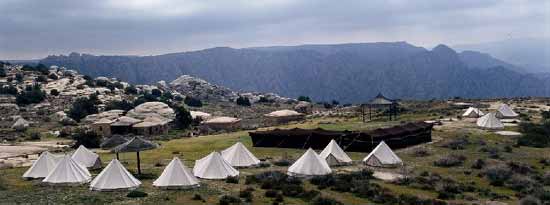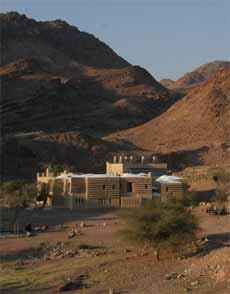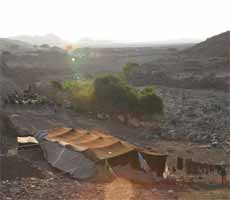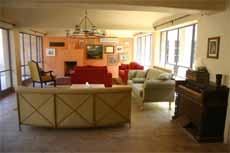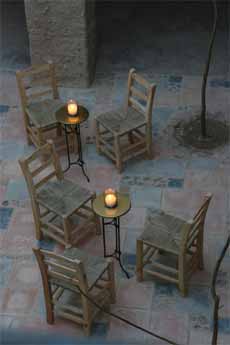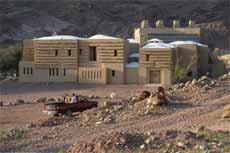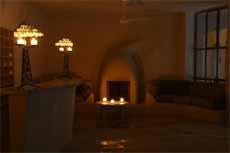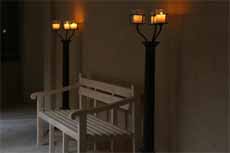Feynan Eco Lodge
Die Feynan Lodge liegt in einer eindrucksvollen Landschaftskulisse im antiken Kupferbergbaugebiet von Feinan. Die Lodge ist sehr geschmackvoll und außergewöhnlich und ein Ort zum Relaxen und entspannen. Es gibt hier es keinen Strom und am Abend wird alles romantisch mit Kerzen und Öllampen beleuchtet.
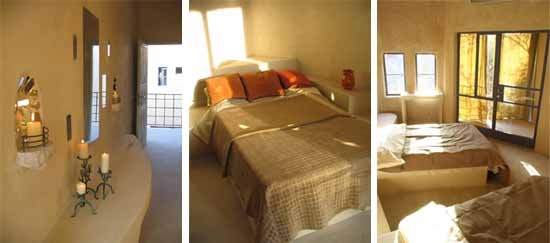
Die Zimmer 26 Zimmer sind
sehr gemütlich ausgestattet und verfügen über ein privates
Badezimmer, haben aber keine Klimaanlage, da es keinen Strom gibt. Die Mauern
sind jedoch sehr dick, so dass auch im Sommer ein angenehmes Klima herrscht.
Von 1. Juli. bis 1 September ist die Lodge geschlossen.
Candle-power lights up the new Wadi Feynan Eco-Lodge
Running deep into the
arid mountains of Jordan's southern rift valley, Wadi Feynan forms the western
gateway to the spectacular Dana Nature Reserve. Here, in this remote and ancient
landscape, just one-and-half hours drive from the seaside town of Aqaba, the
Royal Society for the Conservation of Nature has constructed a unique eco-lodge
to provide a base and accommodation for tourists to explore the natural and
archaeological treasures of Wadi Feynan and the surrounding area.
In terms of archaeological sites in southern Jordan, the Feynan area is regarded
by many experts to be second only to Petra in importance. It shows evidence
of human occupation stretching back 10,000 years, when people were just beginning
to experiment with growing crops.
But what makes Feynan extraordinary is copper mining. It was the first place in the world where copper ore was extracted and smelted for human use. Five thousand years ago, simple, wind-fired kilns were being used to extract pure copper for ornaments, utensils and tools. During the Bronze Age, mining and smelting techniques became more advanced. Extensive narrow galleries were dug to excavate the copper, with vertical shafts to let in air. By the Iron Age, Feynan's copper wealth was under the control of the Edomite Kings who supplied the Assyrian Empire with copper, bringing them unprecedented economic growth. (The Edomite capital was located on the mountain plateau to the east - now the small town of Buseira).
Copper mining reached it peak in Roman times, when the older mines were re-exploited using new technologies. The largest mine in the Roman Empire was located in Umm al-Amad, where you can still see the big, open galleries supported by impressive rock pillars. The most obvious relict of the copper age, however, is not Roman but Byzantine and is known as Khirbet Feynan. This is a large, rounded hill overlooking Wadi Feynan, covered with the ruins of a Byzantine settlement. Here there are three churches, indicating the size and importance of this "copper-powered" community. At the height of its prosperity the Khirbet Feynan community was supplying most of the known world with copper products.
With the opening of RSCN's eco-lodge, scheduled for February 2005, the fascinating archaeology and stunning arid-land scenery of Feynan will soon be accessible for visitors. And the Lodge itself will provide an unparalleled experience in desert accommodation. Isolated from paved roads and electricity supplies, the Lodge is a totally new concept in environment-friendly accommodation.
All the 26 rooms are unique in design and lit by candles at night, creating an extraordinary Arabesque atmosphere, reminiscent of the ancient caravanserai that gave rest and shelter to the camel trains that plied nearby trading routes.
Visitors staying at the Lodge will be able to explore the area on foot, using several hiking trails and long distance links are being created to join Feynan with Shauback and Petra. These will be some of the most stunning mountain trails in the Kingdom. Later in the year, RSCN also has plans to introduce mountain bike and 4x4 trails to give visitors different ways to experience this fascinating area.
